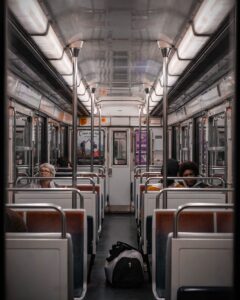New York to install surveillance cameras
in every subway car

Some privacy advocates are worried the move will increase surveillance without necessarily increasing safety.
New York, home of the largest rapid transit system in the country, will install surveillance cameras in every New York City subway car by 2025, Gov. Kathy Hochul announced Tuesday.
The move is aimed at increasing riders’ confidence in subway safety, Hochul said, as ridership numbers are still lagging behind pre-pandemic levels. It also follows several highly publicized crimes that have occurred in the transit system, including the rape of a touriston a subway platform this month; a mass shooting on a subway car in Brooklyn in April that left 10 passengers wounded; and the fatal shooting of a Goldman Sachs employee on a train in May.
But the decision to install cameras on subway cars worries some privacy advocates, who say it will increase the level of surveillance of New Yorkers without necessarily making the subway safer. Subway stations in the city already have surveillance cameras.
“It’s awful. This just seems like a terrible surveillance PR stunt just to boost ridership,” said Albert Fox Cahn, the founder and executive director of the Surveillance Technology Oversight Project (STOP), a nonprofit aimed at reigning in digital surveillance in New York.
“We have no idea how they would be sharing the data with federal and out-of-state partners,” Fox Cahn said.
Subway car footage will be stored on a memory card on each camera, an MTA spokesperson said in an email, but will be available to any local, state or federal law enforcement agency for solving crimes. The MTA is still developing its procurement plan for which camera manufacturer it will use.
In announcing the move, Hochul downplayed privacy concerns.
“You think Big Brother’s watching you on the subways? You’re absolutely right. That is our intent, to get the message out that we are going to be having surveillance of activities on the subway trains and that is going to give people great peace of mind,” Hochul said.
“And if you’re concerned about this, the best answer is don’t commit any crimes on the subways,” she said. “Then you won’t have any problems.”
Several other rapid transit systems in the U.S. already use surveillance cameras, including the San Francisco Bay Area’s BART and Washington Metro in D.C. New York’s project will be the largest such initiative in the country, with two cameras installed in all 6,455 MTA train cars at a cost of $5.5 million. It relies on grant money from the state of New York and the Department of Homeland Security, Hochul said.
As transit surveillance cameras have become more common, some privacy advocates have raised concerns about who manufactures the cameras and stores the video, as well as which law enforcement agencies have access to it.
Instead, Hochul framed the matter of cameras in subway cars as purely one of public safety and rider confidence.
“This is all about safety, the safety of our riders and letting would-be criminals know that should you harm any other passenger in any way, you will be observed, you’ll be caught, and you’ll be prosecuted,” Hochul said.
Janno Lieber, the chair of New York Metropolitan Transportation Authority who joined Hochul at the announcement, told reporters that subway crime was already down almost 9% this year compared to the same period in 2019.
“The subway is among the safest places in New York,” Lieber said, “and the stats are bearing that out.”
